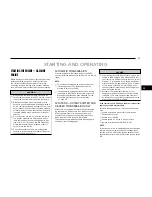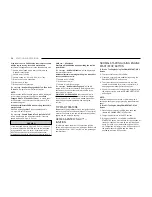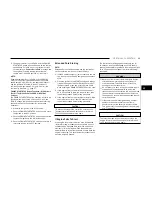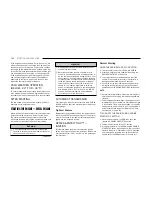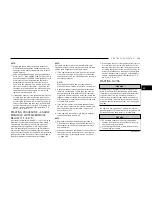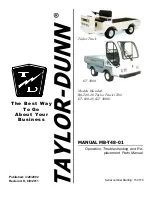
•
Turning on all possible vehicle electrical loads (e.g.
HVAC to max settings, exterior and interior lights,
overloaded power o12 Volts, 115 Volt AC,
USB ports) during certain driving conditions (city
driving, towing, frequent stopping).
•
Installing options like additional lights, upfitter elec-
trical accessories, audio systems, alarms and simi-
lar devices.
•
Unusual driving cycles (short trips separated by long
parking periods).
•
The vehicle was parked for an extended period of
time (weeks, months).
•
The battery was recently replaced and was not
charged completely.
•
The battery was discharged by an electrical load left
on when the vehicle was parked.
•
The battery was used for an extended period with
the engine not running to supply radio, lights, char-
gers, +12 Volt portable appliances like vacuum
cleaners, game consoles and similar devices.
What to do when an electrical load reduction action
message is present (“Battery Saver On” or “Battery
Saver Mode”)
During a trip:
•
Reduce power to unnecessary loads if possible:
○
Turn off redundant lights (interior or exterior).
○
Check what may be plugged in to power outlets
+12 Volts, 115 Volt AC, USB ports.
○
Check HVAC settings (blower, temperature).
○
Check the audio settings (volume).
After a trip:
•
Check if any aftermarket equipment was installed
(additional lights, upfitter electrical accessories,
audio systems, alarms) and review specifications if
any (load and Ignition Off Draw currents).
•
Evaluate the latest driving cycles (distance, driving
time and parking time).
•
The vehicle should have service performed if the
message is still present during consecutive trips
and the evaluation of the vehicle and driving pattern
did not help to identify the cause.
WARNING LIGHTS AND MESSAGES
The warning/indicator lights will illuminate in the instru-
ment panel together with a dedicated message and/or
acoustic signal when applicable. These indications are
indicative and precautionary and as such must not be
considered as exhaustive. Always refer to the informa-
tion in this chapter in the event of a failure indication.
All active telltales will display first if applicable. The sys-
tem check menu may appear different based upon
equipment options and current vehicle status. Some
telltales are optional and may not appear.
RED WARNING LIGHTS
Air Bag Warning Light
This warning light will illuminate to indicate a
fault with the air bag, and will turn on for
four to eight seconds as a bulb check when
the ignition is placed in the ON/RUN or ACC/
ON/RUN position. This light will illuminate with a single
chime when a fault with the air bag has been detected,
it will stay on until the fault is cleared. If the light is not
on during startup, stays on, or turns on while driving,
have the system inspected at an authorized dealer as
soon as possible.
Battery Charge Warning Light
This warning light will illuminate when the
battery is not charging properly. If it stays on
while the engine is running, there may be a
malfunction with the charging system. Con-
tact an authorized dealer as soon as possible.
This indicates a possible problem with the electrical
system or a related component.
Brake Warning Light
This warning light monitors various brake
functions, including brake fluid level and
parking brake application. If the brake light
turns on it may indicate that the parking
brake is applied, that the brake fluid level is low, or that
there is a problem with the Anti-Lock Brake System
reservoir.
If the light remains on when the parking brake has
been disengaged, and the fluid level is at the full mark
on the master cylinder reservoir, it indicates a possible
brake hydraulic system malfunction or that a problem
with the Brake Booster has been detected by the Anti-
Lock Brake System (ABS) / Electronic Stability Control
(ESC) system. In this case, the light will remain on until
the condition has been corrected. If the problem is
related to the brake booster, the ABS pump will run
when applying the brake, and a brake pedal pulsation
may be felt during each stop.
The dual brake system provides a reserve braking
capacity in the event of a failure to a portion of the
hydraulic system. A leak in either half of the dual brake
system is indicated by the Brake Warning Light, which
will turn on when the brake fluid level in the master
cylinder has dropped below a specified level.
The light will remain on until the cause is corrected.
88
GETTING TO KNOW YOUR INSTRUMENT PANEL
Summary of Contents for CHASSIS CAB 2024
Page 69: ...GETTING TO KNOW YOUR INSTRUMENT PANEL MIDLINE INSTRUMENT CLUSTER GASOLINE 67 3...
Page 71: ...HIGHLINE INSTRUMENT CLUSTER GASOLINE GETTING TO KNOW YOUR INSTRUMENT PANEL 69 3...
Page 75: ...MIDLINE INSTRUMENT CLUSTER DIESEL GETTING TO KNOW YOUR INSTRUMENT PANEL 73 3...
Page 77: ...HIGHLINE INSTRUMENT CLUSTER DIESEL GETTING TO KNOW YOUR INSTRUMENT PANEL 75 3...
Page 357: ......
Page 358: ......
























